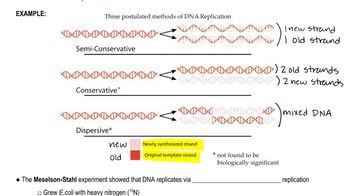Answer the following questions concerning the accuracy of DNA polymerase during replication.
Identify two mechanisms that can correct the kind of abnormality resulting from the circumstances identified in part (c).
Table of contents
- 1. Introduction to Genetics51m
- 2. Mendel's Laws of Inheritance3h 37m
- 3. Extensions to Mendelian Inheritance2h 41m
- 4. Genetic Mapping and Linkage2h 28m
- 5. Genetics of Bacteria and Viruses1h 21m
- 6. Chromosomal Variation1h 48m
- 7. DNA and Chromosome Structure56m
- 8. DNA Replication1h 10m
- 9. Mitosis and Meiosis1h 34m
- 10. Transcription1h 0m
- 11. Translation58m
- 12. Gene Regulation in Prokaryotes1h 19m
- 13. Gene Regulation in Eukaryotes44m
- 14. Genetic Control of Development44m
- 15. Genomes and Genomics1h 50m
- 16. Transposable Elements47m
- 17. Mutation, Repair, and Recombination1h 6m
- 18. Molecular Genetic Tools19m
- 19. Cancer Genetics29m
- 20. Quantitative Genetics1h 26m
- 21. Population Genetics50m
- 22. Evolutionary Genetics29m
17. Mutation, Repair, and Recombination
DNA Repair
Problem 13
Textbook Question
Answer the following questions concerning the accuracy of DNA polymerase during replication.
If a replication error escapes detection and correction, what kind of abnormality is most likely to exist at the site of replication error?
 Verified step by step guidance
Verified step by step guidance1
Understand the role of DNA polymerase in replication: DNA polymerase is responsible for synthesizing new DNA strands by adding nucleotides complementary to the template strand. It also has proofreading activity to correct errors during replication.
Recognize what happens when an error escapes proofreading: If DNA polymerase fails to detect and correct an error, the incorrect nucleotide remains incorporated into the newly synthesized DNA strand.
Identify the type of abnormality caused by the error: The most likely abnormality at the site of replication error is a mismatch between the base pairs. For example, instead of the correct pairing (e.g., adenine with thymine), there may be an incorrect pairing (e.g., adenine with cytosine).
Consider the consequences of the mismatch: This mismatch can lead to a point mutation if the error is not corrected before the next round of replication. A point mutation is a permanent change in the DNA sequence at a single nucleotide position.
Understand the potential impact of the mutation: Depending on the location of the mutation, it may alter the coding sequence of a gene, potentially leading to changes in the protein product or regulatory regions, which can affect gene expression.
 Verified video answer for a similar problem:
Verified video answer for a similar problem:This video solution was recommended by our tutors as helpful for the problem above
Video duration:
2mPlay a video:
Was this helpful?
Key Concepts
Here are the essential concepts you must grasp in order to answer the question correctly.
DNA Polymerase Function
DNA polymerase is an enzyme responsible for synthesizing new DNA strands by adding nucleotides complementary to the template strand during replication. It also has proofreading capabilities, allowing it to detect and correct errors in the newly synthesized DNA. However, if an error escapes this proofreading process, it can lead to mutations in the DNA sequence.
Recommended video:
Guided course

Functional Genomics
Replication Errors
Replication errors occur when DNA polymerase incorporates incorrect nucleotides into the growing DNA strand. These errors can arise from various factors, including chemical damage to DNA or mispairing of bases. If not corrected, these errors can result in permanent changes to the DNA sequence, potentially leading to abnormal protein function or disease.
Recommended video:
Guided course

Semiconservative Replication
Types of Mutations
Mutations are changes in the DNA sequence that can arise from replication errors. The most common types include point mutations, which involve a single nucleotide change, and insertions or deletions, which can alter the reading frame of the genetic code. These mutations can have varying effects on an organism, ranging from benign to harmful, depending on their nature and location within the genome.
Recommended video:
Guided course

Mutations and Phenotypes
Related Videos
Related Practice
Textbook Question
320
views


